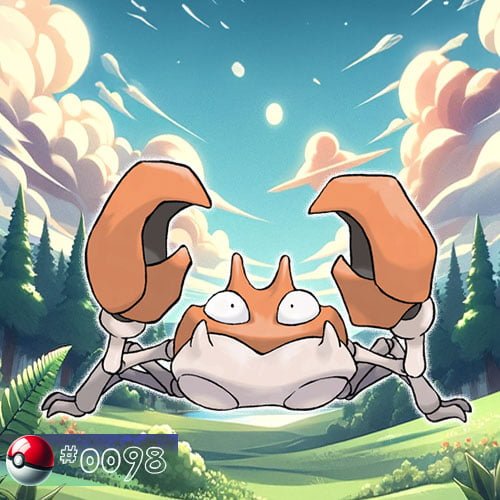Krabby
Krabby is a Water-type Pokémon species in the Pokémon franchise. It resembles a crab with a tough shell and pincers. Known for its water-dwelling nature, Krabby is often found near the ocean.

| National Pokedex No: 0098 |
| Type: |
| Category: River Crab Pokémon |
| Height: 0.4 m (1′04″) |
| Weight : 6.5 kg (14.3 lbs) |
| Gender: 50% ♂, 50 % ♀ |
| Abilities/Hidden abilities:
Hyper Cutter or Shell Armor/Sheer Force |
Biology
Physical Characteristics
Krabby is a crustacean-like Pokémon with distinctive physical characteristics.
Krabby’s exoskeleton is tough and durable, providing a protective shell that covers its body. This shell helps shield Krabby from predators and environmental hazards. The red coloration of Krabby’s exoskeleton is an adaptation to its aquatic habitat. It allows Krabby to blend into its surroundings, offering some level of camouflage.
Krabby’s large pincers are formidable tools with several functionalities. They are used for hunting, capturing prey, and defending against potential threats. The pincers can regenerate if they are damaged or lost, showcasing Krabby’s regenerative capabilities.
Krabby’s eyes are situated on stalks, providing a higher vantage point and increased field of vision. This adaptation aids in detecting both prey and potential predators. Krabby’s mouth is adapted for a carnivorous diet. It can consume a variety of aquatic organisms and small prey found in its habitat.
Krabby’s legs, located beneath its body, are jointed and suitable for movement both in water and on land. These legs contribute to its agility and maneuverability.
Krabby exhibits size differences depending on factors such as age and evolutionary stage. Younger Krabby may be smaller, while Kingler, its evolved form, tends to be larger and more imposing.
These intricate physical features collectively enhance Krabby’s survival in aquatic environments, showcasing its adaptation to both the challenges of the sea and potential terrestrial encounters.
Behaviour
Krabby, known for its presence in both aquatic and coastal environments, exhibits a range of behaviors shaped by its natural instincts and survival strategies.
Krabby prefers habitats with access to both saltwater and land, commonly found near coastlines and shallow waters. It is known to burrow in the sand to create shelter. While Krabby is not excessively territorial, it may defend its chosen burrow or feeding grounds against other Krabby or potential threats.
Krabby tends to be more active during the night, utilizing its stalk-like eyes to navigate in low light conditions. This behavior may help avoid daytime predators. Krabby is a carnivorous Pokémon with a diet that includes various aquatic organisms, small fish, and sometimes plant matter. Its large pincers are effective tools for capturing prey.
Krabby is not highly social, but during certain seasons or when resources are abundant, multiple Krabby may share proximity without aggressive interactions. Krabby likely engages in mating rituals, although specific details are not well-documented. It is known to evolve into Kingler, suggesting a life cycle that involves growth and development.
Krabby is capable of digging burrows in the sand using its pincers. These burrows serve as both shelter and a place to ambush prey, showcasing a blend of defensive and hunting behaviors. When threatened, Krabby displays aggressive defensive behavior. It can use its powerful pincers to fend off attackers and protect itself from potential harm. Krabby’s ability to regenerate its pincers is a noteworthy behavior. This adaptation aids in recovering from battles or encounters where its pincers may be damaged or lost.
Despite being a primarily aquatic Pokémon, Krabby can move on land using its jointed legs. This adaptation allows it to explore and hunt in both aquatic and terrestrial environments.
Krabby’s behaviors are influenced by a combination of its biological traits, environmental conditions, and evolutionary history, making it a versatile and adaptable Pokémon in its natural habitat.
Evolution
Krabby undergoes a straightforward evolutionary process, evolving into Kingler. Here are the details of Krabby’s evolution.
Krabby is a crustacean Pokémon characterized by its tough exoskeleton, large pincers, and aquatic lifestyle. It resides in coastal areas and is known for its burrowing behavior. Krabby evolves primarily through gaining experience in battles and gaining exposure to various challenges in its environment.
Kingler is the evolved form of Krabby and represents a larger, more powerful crustacean Pokémon. It boasts an impressive set of pincers and an enhanced exoskeleton. Krabby evolves into Kingler when it reaches a certain level of experience and maturity. The exact level required for evolution can vary, but it typically occurs as Krabby gains strength and skills through battles and other experiences, and it is level 28 usually.
The evolution results in significant changes to Krabby’s physical appearance. Kingler is larger, more robust, and its pincers become even more formidable. The evolution may also bring about improvements in its overall stats and capabilities. As Kingler, the Pokémon gains access to more potent moves and abilities, making it a stronger and more formidable force in battles. Its evolved form allows it to adapt to a wider range of challenges.
While the core behaviors related to habitat, feeding, and defensive strategies remain consistent, Kingler’s evolved status may influence its interactions with other Pokémon and its role in the ecosystem.
Overall, the evolution of Krabby into Kingler is a natural progression that reflects the Pokémon’s growth and adaptation to its environment. It’s a common pattern seen in many Pokémon species, contributing to the diversity and complexity of the Pokémon world.
Appearances
Anime Main Appearances
Ash’s Krabby
In ”Mystery at the Lighthouse” Ash captured a Krabby, sending it to Professor Oak‘s lab. Krabby made its battling debut in ”Round One – Begin!” at the Indigo Plateau Conference, evolving into Kingler after triumphing over an Exeggutor.
Other appearences include the episodes ”The Evolution Solution” (Krabby playfully grasped Slowpoke‘s tail and Psyduck‘s head with its pincers) and ”Expedition to Onix Island” (One Krabby got caught in a fix with Oshawott and Piplup).
Anime Minor Appearances
Krabby, first introduced at Professor Oak‘s lab (”Mystery at the Lighthouse”), had notable appearances throughout the series. Another Krabby woke Jessie and James in the ”Island of the Giant Pokémon”.
In various episodes, Krabby participated in events such as Florando’s annual Pokémon Exhibition (”Flower Power”), Pokémon Swap Meet (”Tricks of the Trade”), Manalo Stadium (”The Wisdom Not to Run!”) and one also appeared as a part of a movie crew in ”Lights, Camera, Quack-tion”. Goh caught a Krabby on Cero Island (”Getting More Than You Battled For!”), joining his team in Pokémon Journeys: The Series.
This Pokémon made diverse appearances, showcasing its versatility in different settings and storylines across various episodes: ”Pikachu’s Vacation”, ”The Lost Lapras”, ”Pikachu’s Rescue Adventure” (wild one), ”Pokémon Mystery Dungeon: Explorers of Time & Darkness”, ”Bagged Then Tagged!”, ”Teaching the Student Teacher!”, ”The Island of Illusions!”, ”Going for the Gold”, ”Keeping Your Eyes on the Ball!” and others.
Also different Krabby appeared in fantasies in ”Bye Bye Psyduck” (Misty‘s fantasy) and ”Gone Corphishin”.
Multiple Krabby appeared in the episodes ”The Power of One” (disturbed by Lawrence III) and ”Got Miltank?” (three of them seen as residents of Pokémon-exclusive oasis).
A Trainer’s Krabby also in the epsodes:
- ”Hook, Line, and Stinker” (particiated in the annual Seaking Catching Competition)
- ”Secrets of the Jungle”
- ”Take My Thief! Please!”
Manga Appearances
The Electric Tale of Pikachu
In this manga, during the episode ”The Orange Islands”, Ash came to the rescue of a Lapras under attack by a swarm of Krabby.
Pokémon Journeys: The Series
In this manga one Krabby was seen in the ”Getting More than You Battled For!”.
Pokémon Adventures
During “A Tale of Ninetales” Red unintentionally caught a Krabby. Later, in “What a Dragonite,” Krabby was traded for Misty’s Gyarados, Gyara, as a skilled Surf user. It reappeared in “Do Wrong, Dewgong!”. Additionaly Misty rescued another Krabby in “Chinchou in Charge,” earning Suicune’s favor.
In “Murkrow Row” one Krabby was found residing in Gold’s house.
Pokémon Zensho
In the fifth chapter of the Pokémon Zensho manga, PZ06, Satoshi obtained a Krabby and several other Pokémon by trading the Dratini he discovered with a Fisherman.
Game data
Stats
Location
| Game version | Location |
|---|---|
| Pokémon Red | Routes 6, 11, 12, 13, 17, 18, 24, and 25, Cerulean City, Vermilion City, Fuchsia City, Safari Zone |
| Pokémon Blue | Routes 6, 11, 12, 13, 17, 18, 24, and 25, Cerulean City, Vermilion City, Fuchsia City, Safari Zone, Seafoam Islands |
| Pokémon Yellow | Routes 10 and 25, Seafoam Islands |
| Pokémon Gold and Pokémon Silver | Routes 19, 20, 21, 34, 40 and 41, Burned Tower, Cerulean City, Cherrygrove City, Cianwood City, Cinnabar Island, Dark Cave, Olivine City, Whirl Islands |
| Pokémon Crystal | Routes 19, 20, 21, 34, 40 and 41, Burned Tower, Cerulean City, Cherrygrove City, Cianwood City, Cinnabar Island, Dark Cave, Olivine City, Union Cave, Whirl Islands |
| Pokémon Ruby and Pokémon Sapphire | Trade |
| Pokémon FireRed | Routes 4, 10, 11, 12, 13, 19, 20, 21, and 24, Cerulean City, Vermilion City, Seafoam Islands, Cinnabar Island, Pallet Town |
| Pokémon LeafGreen | Routes 4, 10, 11, 12, 13, 19, 20, 21 and 24, Bond Bridge, Cerulean City, Cinnabar Island, Five Island, Five Isle Meadow, Green Path, Icefall Cave, Kindle Road, Memorial Pillar, One Island, Outcast Island, Pallet Town, Resort Gorgeous, Seafoam Islands, Tanoby Ruins, Trainer Tower, Treasure Beach, Vermilion City, Water Labyrinth, Water Path |
| Pokémon Emerald | Trade |
| Pokémon Colosseum | Trade |
| Pokémon XD | Trade |
| Pokémon Diamond and Pokémon Pearl | Route 226 |
| Pokémon Platinum | Route 226 |
| Pokémon HeartGold and Pokémon SoulSilver | Route 19, Cianwood City, Cliff Cave, Seafoam Islands, Whirl Islands |
| Pokémon Black and Pokémon White | Routes 4 and 13, Driftveil City |
| Pokémon Black 2 and Pokémon White 2 | Virbank City, Virbank Complex |
| Pokémon X and Pokémon Y | Friend Safari |
| Pokémon Omega Ruby and Pokémon Alpha Sapphire | Routes 105, 106, 107, 108, and 109 |
| Pokémon Sun and Pokémon Moon | Pokémon Bank |
| Pokémon Ultra Sun and Pokémon Ultra Moon | Pokémon Bank |
| Pokémon: Let's Go, Pikachu! and Pokémon: Let's Go, Eevee! | Routes 10, 12 and 13 |
| Pokémon Sword and Pokémon Shield | South Lake Miloch, West Lake Axewell, Giant's Cap, Fields of Honor, Loop Lagoon |
| Pokémon Brilliant Diamond and Pokémon Shining Pearl | Route 226, Spacious Cave, Dazzling Cave, Stargleam Cavern |
| Legends Arceus | Unobtainable |
| Pokémon Scarlet and Pokémon Violet | Unobtainable |
Krabby's origin name
English: Krabby – The English name “Krabby” is derived from the word “crabby,” which means irritable or bad-tempered. This choice reflects the Pokémon’s crab-like appearance and the potential aggressiveness associated with its large pincers.
Japanese: クラブ (Kurabu) – In Japanese, Krabby is known as “Kurabu,” a direct transliteration of the English word “crab.” This name emphasizes its crustacean nature.
German: Krabby – The German name for Krabby remains the same as in English, maintaining the connection to the word “crabby.”
French: Krabby – Similarly, the French name for Krabby is “Krabby,” preserving the reference to its crab-like characteristics.
Spanish: Krabby – In Spanish, Krabby retains its English name, written as “Krabby.”
Italian: Krabby – The Italian name for Krabby is “Krabby,” mirroring the English and emphasizing its crab-inspired design.
Korean: 크랩 (Keuraeb) – In Korean, Krabby is called “Keuraeb,” reflecting the English pronunciation and maintaining the association with crabs.
Chinese (Simplified): 大钳蟹 (Dà Qián Xiè) – The Simplified Chinese name for Krabby, “大钳蟹,” translates to “Big Pincer Crab,” highlighting its distinctive claws.
Chinese (Traditional): 大鉗蟹 (Dà Qián Xiè) – In Traditional Chinese, Krabby is known as “大鉗蟹,” which also means “Big Pincer Crab.”
Krabby’s names in various languages often focus on its crab-like features, with adaptations to fit linguistic nuances. The common thread is the association with crabs and their defining characteristics, reflecting the Pokémon’s design and behavior.



